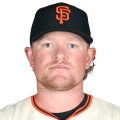2024 Fantasy Baseball Draft Strategy: How you can free yourself from the tyranny of early-round pitching
After my bold act of truth-telling in last year’s starting pitcher preview, it was inevitable that powerful forces would attempt to silence me in 2024. This is what happens when a lone, courageous voice threatens to topple the established order.
Major league pitchers are, to a man, charlatans and grifters, but they are also a formidable, deep-pocketed and well-connected group. Somehow these monsters managed to install one of their puppets, Dalton Del Don, as the author of this season’s Yahoo position primer.
[Join or create a Yahoo Fantasy Baseball league for the 2024 MLB season]
As you’d expect, Dalton’s feature was pure propaganda. He has been a paid spokesperson for Big Pitcher for at least a decade. Once more, he is pushing the outrageous lie that a starting pitcher might conceivably be a reasonable choice in the first round of fantasy drafts.
So, yet again, it falls to me to push back against these frauds and their faithful lapdog, Del Don.
The plain truth about starting pitchers is that they get lazier and less involved each year. These guys have effectively pulled off the dream scam of end-stage capitalism, which is to perform less work for a great deal more money. At some level, you have to respect the scope and brazenness of their long con.
Last year, only five pitchers managed to throw 200 innings and no one reached 220. Logan Webb led MLB with 216. Ten years prior, in 2013, there were 36 different starters who reached the 200-inning plateau and six who topped 220. Go back another decade to 2003 and we find 44 pitchers who reached 200 innings with 11 clearing 220. Roy Halladay’s 266 frames led the majors.

It’s now been eight years since anyone pitched as many as 230 innings in a big league season and 13 years since anyone reached 250. Halladay is the last pitcher to exceed 260. In the earliest years of the fantasy era, league leaders were still throwing 290-300 innings, but those days are buried and those workloads are obviously not coming back.
The pitching lobby and its apologists will of course hit you with a blizzard of misinformation about velocity and analytics and specialization, but let’s not lose sight of the simple fact that these dudes are recording fewer outs and still demanding first-round fantasy status.
It’s scandalous, truly.
I’d like to remind you that in Yahoo rotisserie and full-season points leagues the default innings max is 1,400, an easily reached total for an active manager. Everyone in your league who competes through the end of the season will hit 1,400. Within that context, it’s basically not possible for any of today’s top starters to have the impact of the elite pitchers from the recent past.
That is to say, the peak versions of Johan, Felix, Clemens, Verlander or Kershaw simply cannot be found in the 2024 player pool. There is zero chance that your best pitcher will eat up 18% of your innings cap, as they might have done previously. If you get 180 innings from your fantasy squad’s ace — a total reached by only 25 pitchers last season — that guy will account for 12.9% of your innings.
When Yahoo first began offering fantasy baseball in 1999, Randy Johnson was entering the second season of what would be an insane five-year stretch in which he averaged 255 innings, 349 strikeouts and 20 wins while producing a 2.63 ERA and 1.07 WHIP. Actual ace stuff, by any measure. We’re not peering into the mists of history here, either — this man was dominating in the online era. Johnson wasn’t some mythic figure from an age of train travel and heavy wool flannel uniforms.
[2024 Fantasy Baseball Draft Rankings: C | 1B | 2B | SS | 3B | OF | SP | RP]
Today, it’s tough to find any two starters who might combine to deliver a standard-issue Big Unit season. We should all be indignant about the current state of major league pitching, but instead, we continue to burn early picks on these scoundrels and layabouts.
Allow me to present you with an alternative approach — a blueprint to minimize the risk and pain associated with pitchers while still allowing you to achieve your fantasy goals:
How to avoid early-round pitching in your drafts — and still have success
We don’t consider any starting pitcher inside the top-50 picks, not until we reach the George Kirby-Grayson Rodriguez range;
After selecting our first SP, we wait another 40-50 picks, which means Dylan Cease will be someone else’s problem (or success story);
Under no circumstances do we get hung up on any individual name — not Tarik Skubal, not Eury Perez, not anyone — because, in their hearts, these guys are all trying to hurt us;
We spend the back half of our draft targeting high K-rates, post-hypes, bounce-backs, reclamation projects and other scraps — give me the plausible upside tier, please;
We certainly don’t get hung up on finishing our fantasy rotations in February or March, because, as happens every year, a significant percentage of roster-worthy pitching talent will go undrafted. We need to be in on this year’s Bobby Miller, Tanner Bibee and Cole Ragans. Let’s recall that Spencer Strider was an in-season waiver add two years ago.
There it is, the full plan. Perhaps it’s not for everyone. Some of you have been hopelessly conned by Del Don and the pitching PR machine, regrettably. But I’m here to tell you the design-on-a-dime approach can yield a competitive staff while allowing you to build an unassailable hitting powerhouse. The benefits to using nine of your first 10 selections on batters should be clear; the sweet relief associated with avoiding the luxury pitchers should be similarly obvious.
